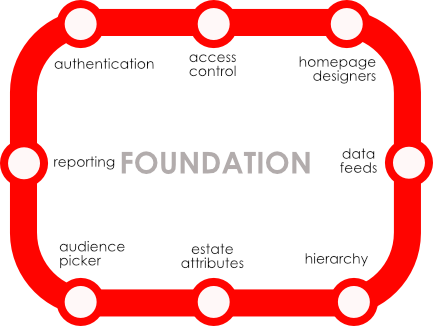Foundation manages your business hierarchy, location attributes, security and authentication as well as facilitating the free movement of data in and out of the platform, and seamlessly between other Metro modules. Should you add another module to your current Metro technology set, existing data is used to minimise configuration/setup time and accelerate the go-live of each module. The value of having ‘one version of the truth’ extends further than accuracy, agility and cost alone. For example, data held within the Employee Management module can be used to target communications or tasks based on the availability, skill sets, workload and capacity of an individual within a store.
Discover more about each module by selecting from the tabs below:
Authentication
Ensuring secure access to Metro is of vital importance. Users can authenticate using various methods ranging from straightforward user names and passwords (these being checked against an authorised list) to the use of Active Directory (AD), Active Directory Federation Services (ADFS) and Lightweight Directory Access Protocol (LDAP). Single Sign On (SSO) tokens can also be used.
Hierarchy
The Hierarchy within metro is used to set up the organisational relationships of your business. For example, Head Office – Regions – Areas – Departments – Roles – Locations – Users – Etc. Fully configurable and with the ability to ‘drag and drop’ groups for instant updates, organisations can quickly and easily replicate, change and maintain how it is organised from an operational perspective.
Access Control
Each metro user account is assigned a role (or multiple roles). The roll(s) determine the user’s level within the metro hierarchy. Each role is set with security permissions that allow the user to see only the relevant functions available to their level and position.
Estate Attributes
Metro allows businesses to create and hold site/estate attributes so that, in turn, they can easily apply these within the Audience Picker to enable targeted communications and applications. For example, if you held within the estate attributes how many windows or how big a building is, you can use this information to filter and direct communications/tasks to only those sites with X windows and smaller or larger than Y in size.
Homepage Design
The Home Page Designer tool enables businesses to create and personalise each homepage’s look, feel, and functionality within Metro. Within the Homepage Designer, you can add a host of features to increase the appeal of homepages and make these as simple or complex as you want in terms of appearance and functionality. In addition, each homepage can be optimised for viewing across multiple platforms, from handheld devices to tablets, laptops and Desktop PCs.
Audience Picker
Metro uses an Audience picker to select and target recipients to address content to the correct audience (based on location or user attributes). Audience levels are user-defined and configurable to ensure content or tasks do not go to users who do not need to receive it or cannot complete specific tasks.
Data Feeds
Data can be imported into metro using application programming interfaces (APIs) or more traditional methods such as CSV / Excel uploads, etc. Exports from the system are also handled in the same way.
Reporting
A wide variety of standard reports are available for users. Extracts can be viewed in various formats, enabling users to export business information relevant to their needs. Report exports can be generated in CSV, Excel, or metro’s standard application programming interfaces (APIs).
Is your tech stack causing technology challenges?
On average, retailers use between 15 to 30 different software tools in their operational tech stack, with many of these fractured, operating in silos and with diverse commercial, support, and integration approaches. That might be surprising to some, but it's a big...
What’s our USP?
We’ve shared before what keeps Metro on the top spot for branch control and communication, but one question that comes up from time to time is “What’s Metro’s USP”? Let's take a look... For every application Metro offers, there are countless other vendors out there...
Is your organisation’s efficiency clogged up with Toxic Technology?
Toxic technology - It's nobody's fault but the inevitability of developing and purchasing individual applications to solve single problems. In isolation this can work fine, automating processes and bringing productivity gains to the individuals utilising the...

